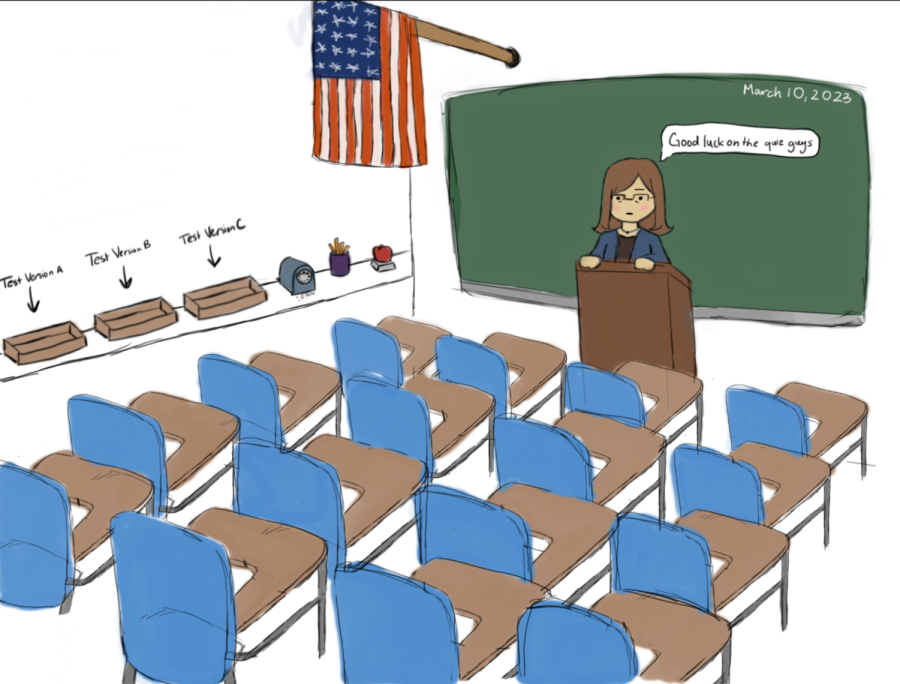A Case of Test Flu
How Skipping Tests Creates a Variety of Problems for Teachers and Students
Test flu is a highly contagious disease that has been targeting overwhelmed high school students for years. Many students participate in extracurricular activities, sports and community service on top of their heavy course load to improve their resumes.
These packed schedules create a high stress environment that allows test flu to infect the student and give them the mindset that they can’t allot time in their schedule to prepare for exams.
An academic habit many students have adopted is to skip the original test and quiz days in order to temporarily relieve stress. Hypothetically, students should quickly bounce back after missing one assessment, but in reality skipping class causes problems for students and teachers alike.
Contrary to popular belief, skipping class to create more time to study has not been an effective strategy for most students. A common trend observed by teachers is that taking the test later doesn’t result in improved performance.
“In my experience, they don’t do better, they do worse. Material doesn’t stop coming and we move on to the next unit and they’re studying twice to keep up with the current unit as well as review for the test,” said AP Math teacher Michael Swatek.
Students that take the tests on later dates often hear previews of the test from classmates. To prevent cheating, many teachers make multiple versions of each test with slightly modified questions.
“I have to spend so much time making different versions of the test, to the point where it takes me five times longer to make the test than it takes for kids to take it. I’m old, it shouldn’t be that way,” said AP Social Science teacher Louis Harley.
“If the student is consistently missing the test if they have “test flu’’ or if I see them walking around a couple hours after the test it drives me crazy. That’s not honest behavior and they’re trying to get an advantage,” he continued.
One disadvantage of taking make-up tests during later class periods is that the student is unable to ask the teacher for clarification regarding difficult test questions. This is because the teacher is busy teaching the next content as scheduled and they are unable to help the student working on prior material.
“I build a system where a person should be able to see the rewards of being there on test day. That can be like facts I give them at test time like ‘Here’s how this test links to what we did in class this week,” said AP Physics teacher James Warren.
“I can’t give those facts on make-up test day, it’s impossible to do that. When someone dodges a test [and] puts us in an impossible situation, then we don’t have the resources to help them. I try to show them how the normal schedule of doing things provides the best resources for students to learn.”
Not only is the student taking a make-up test unable to ask for help, but they are also missing out on the crucial information that is being taught.
“As a veteran teacher, I backwards map from the AP Exam date. If a kid is out on the test, that puts [the student] behind. The next class they show up, I’m lecturing [and] they’re taking a test. The next day after that I’m doing a lab based on what I just lectured [and] now they’re joining a lab they don’t know [anything] about. It just kind of snowballs,” said AP Environmental Science teacher Marie Kuhn.
Noticing a couple absences here and there may mislead Sea Kings to believe that skipping on quiz or test days is an uncommon academic habit.
Swatek conducted a study on the correlation between quiz days and the average percentage of students absent.
He found that an average of 9.4% of his students are absent on regular class days and that number spikes to 24% on quiz days which provides evidence that there is a strong relationship between assessments and attendance.
“My average [percentage of students absent on quiz days] is 24% and that ranges anywhere from 11%, which is reasonable, to 39.3% absence rate. That’s a lot, a quarter of the class gone, on average, on quiz days,” Swatek said.
“If it’s just by chance that on quiz days they are absent like this, I’d only get this average of 24% once out of 100,000 times according to the statistical study that I did. This implies that people are skipping on purpose.”
The pandemic forced teachers to be more accommodating when students were absent while quarantining with COVID-19. However, this created a standard for students that make-up tests will always be available, regardless whether or not the absence was for a legitimate reason.
“Since COVID, some kids have gotten used to taking everything open note or at home and I think that has an effect on people,” said Harley. “I’ve had kids tell me ‘Can I just use my phone’ and it was only two years ago, so I think most kids have that memory of COVID time where you could look everything up.”
The schedule teachers spend time making is done to benefit their students, especially in AP classes that have a month less time to teach the material.
“I’ve told [students] from the beginning it’s important to be here on test days and it’s an AP college level class and they’re going to have to learn that. If they try to pull that in college and miss a test, they get a 0. I think that will be a rude awakening for some people,” Kuhn said.
“The effort you put in is the result you get out and there’s a famous quote. ‘If you always do what you always did, you always get what you always got.’”
